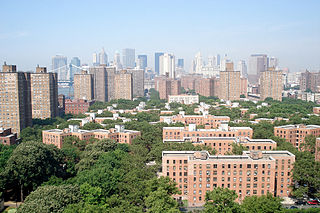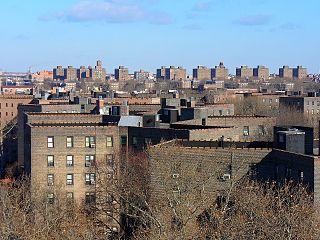
Queensbridge Houses, also known simply as Queensbridge, is a public housing development in the Long Island City neighborhood of Queens, New York City. Owned by the New York City Housing Authority, the development contains 29 buildings and 3,142 units accommodating approximately 7,000 people in two separate complexes. The complex opened in 1939 and is the largest housing project in North America.

East New York is a residential neighborhood in the eastern section of the borough of Brooklyn in New York City, United States. Its boundaries, starting from the north and moving clockwise, are roughly the Cemetery Belt and the Queens borough line to the north; the Queens borough line to the east; Jamaica Bay to the south, and the Bay Ridge Branch railroad tracks and Van Sinderen Avenue to the west. Linden Boulevard, Pennsylvania Avenue, and Atlantic Avenue are the primary thoroughfares through East New York.
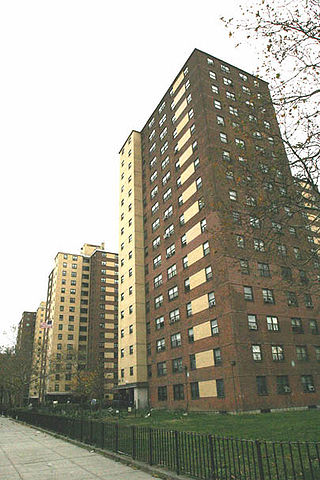
Brownsville is a residential neighborhood in eastern Brooklyn in New York City. The neighborhood is generally bordered by Crown Heights to the northwest; Bedford–Stuyvesant and Cypress Hills to the north; East New York to the east; Canarsie to the south; and East Flatbush to the west.

The New York City Housing Authority (NYCHA) is a public development corporation which provides public housing in New York City, and is the largest public housing authority in North America. Created in 1934 as the first agency of its kind in the United States, it aims to provide decent, affordable housing for low- and moderate-income New Yorkers throughout the five boroughs of New York City. NYCHA also administers a citywide Section 8 Leased Housing Program in rental apartments. NYCHA developments include single and double family houses, apartment units, singular floors, and shared small building units, and commonly have large income disparities with their respective surrounding neighborhood or community. These developments, particularly those including large-scale apartment buildings, are often referred to in popular culture as "projects."

Crotona Park East, also known as Crotona or East Morrisania, is a residential neighborhood geographically located in the southwest Bronx in New York City. Crotona Park East is considered part of the South Bronx. Its boundaries, starting from the north and moving clockwise are the Cross-Bronx Expressway to the north, the Bronx River to the east, East 167th Street to the south, and Crotona/Prospect Avenues to the west. Southern Boulevard is the primary thoroughfare through the area. The neighborhood is adjacent to, but distinct from, the nearby park named Crotona Park.

West Farms is a residential neighborhood in The Bronx, New York City. Its boundaries, are: Bronx Park to the north, the Bronx River Parkway to the east, the Cross-Bronx Expressway to the south, and Southern Boulevard to the west. East Tremont Avenue is the primary thoroughfare through West Farms.

Castle Hill is a neighborhood located in the southeast section of the borough of the Bronx in New York City. Its boundaries are Waterbury Avenue and Westchester Avenue to the north, Westchester Creek to the east, the East River to the south, and White Plains Road to the west. Unionport is a subsection of Castle Hill, typically considered north of Lafayette Avenue.
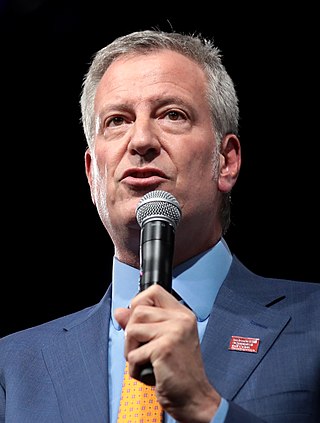
Bill de Blasio is an American politician who served as the 109th mayor of New York City from 2014 to 2021. A member of the Democratic Party, he held the office of New York City Public Advocate from 2010 to 2013.

The Robert Fulton Houses is a housing project located in the Chelsea neighborhood of Manhattan in New York City, owned and operated by the New York City Housing Authority (NYCHA). The 6.27-acre (2.54 ha) site is located between West 16th and 19th Streets and bounded by Ninth and Tenth Avenues. The project consists of 945 apartments in eleven buildings; three of the developments are 25 stories, while the others are 6 stories high.
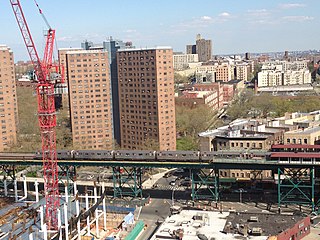
Manhattanville Houses is a public housing project in the Manhattanville section of West Harlem, in the borough of Manhattan, New York City. The project is located between Broadway and Amsterdam Avenue, spanning a superblock from 129th Street to 133rd Street and is managed by the New York City Housing Authority. The project consists of six 20-story buildings containing 1,272 apartment units.

The John Haynes Holmes Towers is a public housing project for low income residents of the Yorkville section of the Upper East Side located just south of the neighborhood's northern limit at 96th Street, in New York City, New York, United States. The neighboring Isaacs Houses and the Holmes Towers border East Harlem, which has the second highest concentration of public housing in the United States. The two public housing buildings, designed by Architects Eggers and Higgins, were completed in 1969, are 25 stories tall and contain 537 apartments. The project is located between 92nd and 93rd Streets from 1st Avenue to York Avenue and the FDR Drive.

Bernard M. Baruch Houses, or Baruch Houses, is a public housing development built by the New York City Housing Authority (NYCHA) on the Lower East Side of Manhattan. Baruch Houses is bounded by Franklin D. Roosevelt East River Drive to the east, E. Houston Street to the north, Columbia Street to the west, and Delancey Street to the south. The complex, the largest NYCHA development in Manhattan, occupies 27.64 acres (111,900 m2), of which buildings cover 13.4%, a percentage similar to that of most "tower in the park" project designs. It has 2,194 apartments, which house an estimated 5,397 people. These apartments are distributed throughout 17 buildings. Baruch Houses I is seven stories tall, Baruch Houses XI, XIII, and XV are thirteen stories tall, and the rest are fourteen stories tall. Combined, these buildings have 2.9 million square feet (270,000 m2).
Vertical patrol is a form of patrol involving posting officers on different floors in buildings simultaneously.
Akai Gurley, a 28-year-old black man, was fatally shot on November 20, 2014, in Brooklyn, New York City, United States, by a New York City Police Department officer. Two police officers, patrolling stairwells in the New York City Housing Authority (NYCHA)'s Louis H. Pink Houses in East New York, Brooklyn, entered a pitch-dark, unlit stairwell. Officer Peter Liang, 27, had his firearm drawn. Gurley and his girlfriend entered the seventh-floor stairwell, fourteen steps below them. Liang fired his weapon; the shot ricocheted off a wall and fatally struck Gurley in the chest. A jury convicted Liang of manslaughter, which a court later reduced to criminally negligent homicide.

The Farragut Houses is a public housing project located in the downtown neighborhood of northwestern Brooklyn, New York City, bordering the Brooklyn Navy Yard. Farragut Houses is a property of New York City Housing Authority (NYCHA). The houses contain 3,272 residents who reside in ten buildings that are each 13 to 14 stories high.
Community gardens in New York City are urban green spaces created and cared for by city residents who steward the often underutilized land. There are over 550 community gardens on city property, over 745 school gardens, over 100 gardens in land trusts, and over 700 gardens at public housing developments throughout New York City. The community garden movement in NYC began in the Lower East Side during the disrepair of the 1960s on vacant, unused land. These first gardens were tended without governmental permission or assistance.

The Red Hook Houses are two connected public housing complexes located in Red Hook, Brooklyn, New York City. Managed by the New York City Housing Authority (NYCHA), they comprise the largest housing development in Brooklyn.
Kingsborough Houses-Kingsborough Extension, also known as Kingsborough Houses, is a housing project in Brooklyn, New York covering 15.97-acres in Crown Heights, and is bordered by Ralph and Rochester Avenues, and Pacific and Bergen Streets. The project consists of 16, six-story buildings with 1,148 apartment units. It is owned and managed by New York City Housing Authority.

Edenwald Houses are a housing project in the Eastchester and Laconia neighborhoods of the Bronx, New York City. Established on October 30, 1953, the project consists of forty buildings, 3 and 14 stories tall with 2,039 apartment units. It covers a 48.88-acre development is bordered by Grenada Place, East 225th Street, Baychester Avenue, Schieffelin Avenue and Laconia Avenues. It is owned and managed by New York City Housing Authority (NYCHA) and is the largest development in the Bronx.













